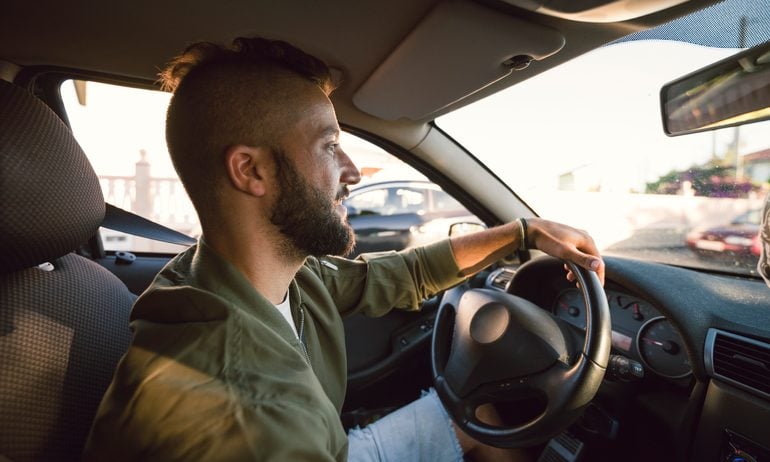What Is Uninsured Motorist Coverage?
Uninsured motorist insurance can spare you from shelling out money for crashes you didn’t cause.

Many, or all, of the products featured on this page are from our advertising partners who compensate us when you take certain actions on our website or click to take an action on their website. However, this does not influence our evaluations. Our opinions are our own. Here is a list of our partners and here's how we make money.
Uninsured motorist insurance spares you from shelling out your own money for injuries or property damage from crashes you didn’t cause. Some states require this coverage, although it is available to most U.S. drivers. And it usually doesn’t cost much to add to your auto policy.
Here's what to know about uninsured motorist coverage.

See what you could save on car insurance
Easily compare personalized rates to see how much switching car insurance could save you.How uninsured motorist coverage works
An uninsured motorist is a person who has no liability car insurance. When you’re in an accident and the other driver is at fault, their insurance is supposed to pay for your car repairs and medical costs for you and your passengers. If the other driver doesn’t have insurance and can’t pay, you can wind up paying the bill.
Uninsured motorist coverage is designed to close the gap between your costs and the other driver’s ability to pay.
Uninsured vs. underinsured motorist coverage
Uninsured motorist coverage is often sold with underinsured motorist coverage. They both pay for the same types of expenses after an accident, with one key difference: Uninsured motorist coverage pays after a crash with an at-fault driver who has no insurance, while underinsured motorist coverage is reserved for accidents with an at-fault driver who has some insurance, but not enough to cover all costs.
Learn more about underinsured motorist coverage.
What does uninsured motorist coverage pay for?
Uninsured motorist coverage pays for injuries or damages that you, family members in your household or passengers in your car suffer after an accident with an at-fault driver who has no insurance.
There are two types of uninsured motorist coverage:
Uninsured motorist bodily injury, or UMBI, pays for medical bills, pain and suffering, lost wages if you can’t work after an accident and funeral expenses after a crash with an at-fault driver who doesn’t have car insurance. It may also cover you if an uninsured driver hits you as a pedestrian or while riding your bike.
Uninsured motorist property damage, or UMPD, pays for damage to your car or property after an accident with an at-fault driver with no car insurance. If you live in a state that requires a deductible for this type of coverage, you are responsible for paying a certain amount of a claim and then your insurance will cover the rest (up to your policy limit).
If you're looking for even more protection, you may want to consider full coverage insurance. However, there's no such thing as a "full coverage policy" — that's just the word used to describe a policy that includes comprehensive and collision insurance as well as your state's minimum car insurance requirements.
Which states require uninsured motorist coverage?
Drivers in 20 states and Washington, D.C., are required to carry uninsured motorist coverage. Car insurance isn’t mandatory in Virginia, but if drivers do purchase a policy, it must include both uninsured motorist bodily injury and property damage coverage. Some states require you to reject the coverage in writing if you don’t want it.
Even if uninsured motorist coverage isn’t required where you live, you may still want the extra security it provides. Roughly 13% of drivers nationwide — or about 1 in 8 — drove uninsured in 2019, according to a 2021 study by the Insurance Research Council, the most recent data available.
Use the table below to see your state’s uninsured motorist coverage requirements.
State | Uninsured/Underinsured Motorist Coverage Requirements |
|---|---|
Coverage is optional but may not be offered by all insurers. | |
Coverage is optional but may not be offered by all insurers. | |
Coverage is optional but may not be offered by all insurers. | |
Coverage is optional but may not be offered by all insurers. | |
Coverage is optional but may not be offered by all insurers. | |
Coverage is optional but may not be offered by all insurers. | |
UMBI & UIMBI required. $25,000 per person/$50,000 per accident | |
Coverage is optional but may not be offered by all insurers. | |
Coverage is optional but may not be offered by all insurers. | |
Coverage is optional but may not be offered by all insurers. | |
Coverage is optional but may not be offered by all insurers. | |
Coverage is optional but may not be offered by all insurers. | |
UMBI required. $25,000 per person/$50,000 per accident | |
Coverage is optional but may not be offered by all insurers. | |
Coverage is optional but may not be offered by all insurers. | |
UMBI & UIMBI required. $25,000 per person/$50,000 per accident | |
Coverage is optional but may not be offered by all insurers. | |
Coverage is optional but may not be offered by all insurers. | |
UMBI & UIMBI required. $50,000 per person/$100,000 per accident | |
UMBI/UIMBI required: $30,000 per person/$60,000 per accident UMPD/UIMPD required: $15,000 per accident | |
UMBI required. $20,000 per person/$40,000 per accident | |
Coverage is optional but may not be offered by all insurers. | |
UMBI/UIMBI required. $25,000 per person/$50,000 per accident | |
Coverage is optional but may not be offered by all insurers. | |
UMBI required. $25,000 per person/$50,000 per accident | |
Coverage is optional but may not be offered by all insurers. | |
UMBI/UIMBI required. $25,000 per person/$50,000 per accident | |
Coverage is optional but may not be offered by all insurers. | |
UMBI/UIMBI required: $25,000 per person/$50,000 per accident UMPD/UIMPD required: $25,000 per accident | |
Coverage is optional but may not be offered by all insurers. | |
Coverage is optional but may not be offered by all insurers. | |
UMBI required. $25,000 per person/$50,000 per accident | |
UMBI required: $30,000 per person/$60,000 per accident UMPD required: $25,000 per accident | |
UMBI/UIMBI required. $25,000 per person/$50,000 per accident | |
Coverage is optional but may not be offered by all insurers. | |
Coverage is optional but may not be offered by all insurers. | |
UMBI required. $25,000 per person/$50,000 per accident | |
Coverage is optional but may not be offered by all insurers. | |
Coverage is optional but may not be offered by all insurers. | |
UMBI required: $25,000 per person/$50,000 per accident UMPD required: $25,000 per accident | |
UMBI/UIMBI required. $25,000 per person/$50,000 per accident | |
Coverage is optional but may not be offered by all insurers. | |
Coverage is optional but may not be offered by all insurers. | |
Coverage is optional but may not be offered by all insurers. | |
UMBI/UIMBI required: $50,000 per person/$100,000 per accident UMPD/UIMPD required: $10,000 per accident | |
UMBI/UIMBI required: $25,000 per person/$50,000 per accident UMPD/UIMPD required: $20,000 per accident | |
Coverage is optional but may not be offered by all insurers. | |
UMBI required: $25,000 per person/$50,000 per accident UMPD required: $5,000 per accident | |
UMBI required: $25,000 per person/$50,000 per accident UMPD required: $25,000 per accident | |
UMBI required. $25,000 per person/$50,000 per accident | |
Coverage is optional but may not be offered by all insurers. | |
*Car insurance in Virginia is not required, but if purchased, uninsured motorist coverage is required at these minimum limits. | |
» MORE: Get free car insurance quotes

See what you could save on car insurance
Easily compare personalized rates to see how much switching car insurance could save you.The cost of uninsured motorist coverage
Compared with other types of coverage in an auto policy, prices for uninsured motorist insurance are relatively low. However, uninsured motorist coverage can be more expensive in states with a higher number of uninsured drivers.
Since liability insurance is meant to protect your assets should you cause a wreck, you would want the same financial assurance if someone else caused the wreck. For that reason, it’s standard to purchase uninsured motorist coverage in at least the same amounts as your liability limits.
Policy limits are the maximum amounts your insurance will pay per claim. If you choose an amount of uninsured motorist coverage that matches the limit of your liability insurance, you should have the same amount of coverage whether the accident is caused by you or by an uninsured driver.
The more assets you have in your name and the more liability insurance you purchase, the higher your costs for uninsured motorist coverage are likely to be.
Still, uninsured motorist insurance is cheaper than liability coverage when purchased in the same amounts — generally less than half the cost.
'Stacked' uninsured motorist coverage
Depending on your state and insurance company, you may have the option to “stack” your uninsured motorist coverage. For an extra cost, you can combine uninsured motorist bodily injury limits for multiple vehicles — either under one policy or across several policies in your name — to increase the overall coverage in an accident.
Say you own two cars insured under one policy, each with $50,000 of uninsured motorist bodily injury coverage. If you choose to stack the coverage, any injury expenses from an accident with an at-fault uninsured driver would be covered up to $100,000, the total stacked policy limit.



